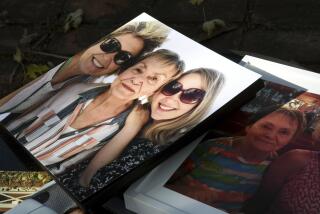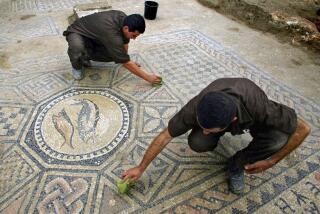Burial Box of Jesusâ Brother Ruled a Fraud
The burial box purported to have held the bones of âJames ... brother of Jesusâ -- hailed as one of the greatest discoveries of New Testament archeology -- is a fraud, the Israeli Antiquities Authority said Wednesday.
Although the stone box itself is authentic, the inscription linking it to James is a modern forgery that was cleverly disguised with an artificial patina that made it appear to be 2,000 years old, a committee of experts has unanimously agreed.
Using sophisticated scientific techniques, the committee was able to gradually peel back the layers of fraud, proving that the burial boxâs inscription was an artfully prepared forgery that appeared ancient but that was, in fact, the archeological equivalent of a Mona Lisa painted last week.
âThe inscription appears new, written in modernity by someone attempting to reproduce ancient written characters,â the authorityâs statement said.
The committee also said that another recently discovered artifact, the so-called Jehoash inscription purporting to be an account of repairs made to Solomonâs Temple in Jerusalem, was a more obvious fraud that may have been produced by the same forger.
If genuine, the two artifacts would have been among the most important ever found for Christianity and Judaism. The first was claimed to be the only archeological evidence of the existence of Jesus. The second was purportedly the only non-biblical evidence of the existence of the great temple.
Both were owned by a Jerusalem collector, Oded Golan, who claimed to have purchased them from antiquities dealers but could not remember the details of the transactions. Golan, a 51-year-old managing director of two engineering companies in Tel Aviv, has been acquiring items since his teens; his collection is reputedly one of the countryâs largest.
The antiquities authority is now investigating his acquisition of both artifacts.
Golan denied the authorityâs allegations Wednesday in a statement to Associated Press. âIâm certain that the committee is wrong regarding its conclusions,â he said, but he is unlikely to draw much support.
âThis proves beyond the pale that the inscription is modern,â said Kristin M. Romey, managing editor of Archaelogy magazine, which will publish a manuscript from committee members this year. âThese are some of the top people in the field. It is pretty conclusive.â
The existence of the James bone box -- technically, an ossuary -- came to light in October with the publication of an article in the magazine Biblical Archaeology Review. Paleographer Andre Lemaire of the Sorbonne University in Paris described the 20-inch-long limestone box, which was inscribed with the Aramaic phrase, âJames, son of Joseph, brother of Jesus.â
A report from the Geological Survey of Israel supported the antiquity of the ossuary and Lemaire vouched for the authenticity of the inscription. Time magazine called it possibly âthe most important discovery in the history of New Testament archeology.â
Golan claimed to have purchased it 30 years ago for $200 to $700 from an antiquities dealer. It has since been insured for more than $1 million.
In earlier interviews, he said it sat in his parentsâ home for years because he was unaware of its potential significance. This story is important because, if the ossuary were discovered after 1978, it would belong to the state of Israel.
Golan has a long interest in antiquities. According to Archaeology magazine, his mother said Golan was digging at a neighborhood site at the age of 8. His brother Yaron recalls him gluing potsherds together at an early age and befriending noted archeologist Yigael Yadin. Golan participated in Yadinâs excavations at Masada when he was 11.
The ossuary was easily his greatest acquisition, but its lack of archeological provenance made many experts suspicious. âNobody knew where it came from,â Romey said. âPeople wanted to believe in it, but everybody was holding their breath.â
To settle questions about the authenticity of both artifacts, the antiquities authority organized a blue ribbon panel to study them. The key evidence turned out to be geological.
Geologists Yuval Goren of Tel Aviv University and Avner Ayalon of the Geological Survey of Israel identified three distinct coatings on the surface of the ossuary:
* A thin, brown veneer of clay and other minerals cemented to the rock surface, the so-called varnish created by bacteria or algae on rocks over long periods.
* A crusty, natural coating of patina that formed from deposition of calcium carbonate as water evaporated from the surface of the stone over the centuries. This patina is similar to the scale left behind in a teakettle.
* A unique composite material that Goren called the âJames Bond,â because it was bonded only into the incised letters of the inscription. This material was powdered chalk that was suspended in water and daubed onto the inscription.
Isotopic studies showed that the calcium carbonate crystals in the âJames Bondâ were produced by the evaporation of heated water, while those on the rest of the patina were produced by evaporation of water at room temperature. That isotopic evidence is âparticularly damning,â Romey said.
The committee concluded that the forger found the words and phrases used in the inscription on genuine artifacts, scanned them into a computer, resized them so they were all the same size, then used a program such as Adobe Photoshop or PageMaker to create a puzzlingly authentic template. The committee identified potential sources for each word or phrase.
âIf I were a forger, thatâs the way I would do it,â said archeologist P. Kyle McCarter of Johns Hopkins University.
Using the template, the forger then incised the letters through the original varnish and patina of the genuine ossuary, then applied the fake âJames Bondâ to the letters to make them appear equally old, the committee said.
Undaunted by this evidence, Hershel Shanks, editor of the Biblical Archaeology Review, said he still supported the ossuaryâs authenticity, noting that it had been verified by the previous study by the Geological Institute of Israel and by researchers at Torontoâs Royal Ontario Museum, where the box was displayed last year. âThe jury is still out,â he said.
But others noted that neither of the earlier studies was as inclusive as the new one. McCarter noted that the first analysis by the geological institute was âunusually cursory.â
âI remember saying what was primarily needed was for it to go to another laboratory for a full analysis,â he said.
The conclusion that the Jehoash inscription is fraudulent was less controversial, because most researchers already doubted its authenticity.
The shoebox-sized tablet, whose existence was revealed in January, is inscribed with 15 lines of Hebrew-Phoenician text -- very similar to a passage in the Old Testament -- about repairs to the temple. The patina seems to contains microscopic carbon fragments and gold globules, presumably from the burning of the temple.
Experts immediately attacked the tablet because of obvious grammatical errors. That assessment was affirmed Wednesday by committee member Avigdor Victor Horwitz, an epigrapher at Ben-Gurion University of the Negev. Every passage on the tablet contained a linguistic mistake, he told a news conference. âThe person who wrote the inscription was a person who thinks in modern Hebrew,â he said. âA person thinking in biblical Hebrew would see it as ridiculous.â
The geological evidence was even more damning. The patina on the letters was almost identical to the âJames Bondâ on the ossuary, except it included carbon particles and fine metal droplets to simulate exposure to fire. Also, Goren discovered this patina could easily be rubbed off the letters, revealing unmistakably fresh engraving marks.
More to Read
Sign up for Essential California
The most important California stories and recommendations in your inbox every morning.
You may occasionally receive promotional content from the Los Angeles Times.










